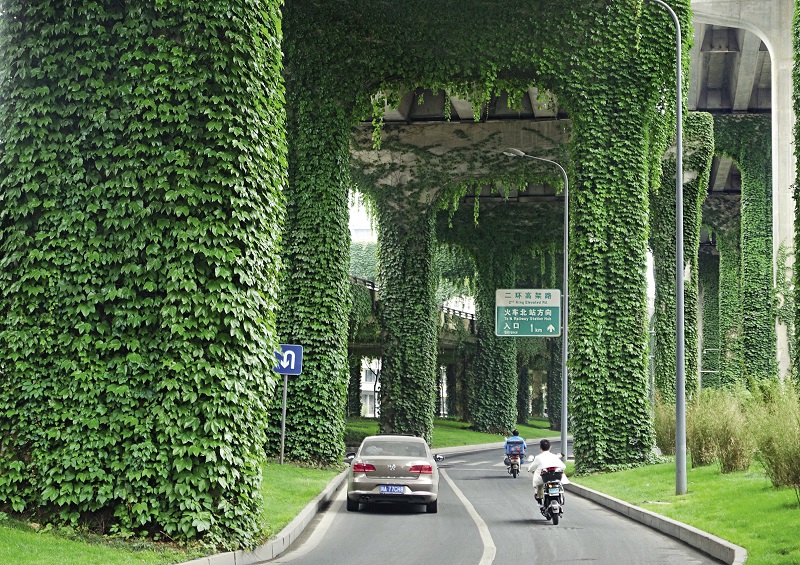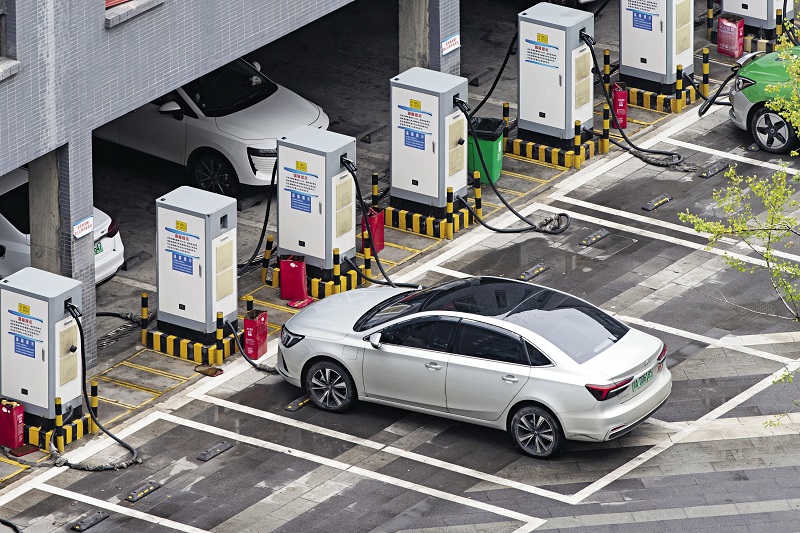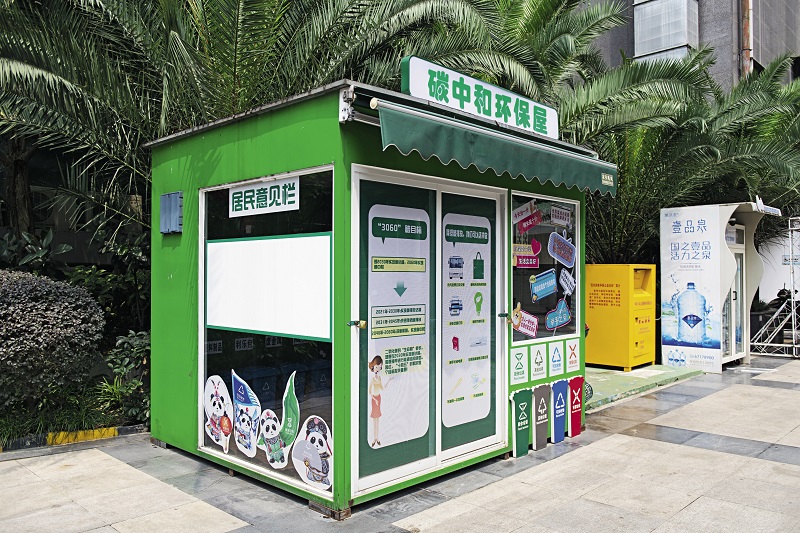A new glass house at the entrance of a residential community in Chengdu, capital of Sichuan Province in southwest China, has become a local attraction. It is a project to promote the “recycle and earn double” program. People are paid money when they leave their recyclable scraps here. In addition, they also get points because by doing so they are helping recycling and reducing their carbon footprint. When they accumulate points, they get a proportionate amount of money as a reward. This, together with the money they have been paid for the recyclable waste, means they “earn double.”

As temperatures begin to rise on April 22, 2021, an overpass along the second ring road of Chengdu is covered by a layer of ivy, forming a green tunnel under the overpass.
Recycle and Earn Double
This innovative glass house was put into use in January. Inside, you can see the waste being sorted into five categories: textiles, glassware, plastic, metal, and paper scraps. The staff tell inexperienced residents in which bin to put their waste and an electronic weighing machine lying in a corner weighs the matter. Once the waste has been weighed, a QR code pops up on the machine’s screen. The person who has brought the waste scans it with a mobile phone and the machine calculates his/her reward. It is then immediately credited into his/her WeChat wallet. The fast and straightforward process – weighing-converting-earning – has made the glass house popular among residents.
Besides this payment, a further bonus of RMB 100 (US $15.5) is given when the amount of recyclable waste brought by a person reaches one tonne. Though small in scale, every time a resident brings in recyclable waste to the glass house, it is a contribution to the national campaign to reduce pollution and mitigate climate change. With this and other innovations, Chengdu is gearing up to become China’s carbon-neutral pilot city.
Another innovation is introducing “Low-carbon Chengdu,” a platform for green public welfare. It can be accessed through its website and app. It also has its own official account on WeChat, perhaps the most popular social media, communication, and online payment platform in China. One can earn points on this platform by switching from traditional energy vehicles to new-energy vehicles, riding sharing bikes, or taking snapshots of pollution being caused somewhere.
Click on the app and a panda appears on screen. It is Tantan, the mascot of Low-carbon Chengdu. He interacts with users, providing information on biodiversity, carbon emission reduction, and other aspects of environmental protection, and encourages them to follow a low-carbon lifestyle.
In 2020, the Chengdu authorities began promoting a “twofold encouragement” policy to reduce carbon emissions. It is called twofold because it targets both residents and enterprises. Residents are encouraged to reduce their carbon footprint by walking to their destinations if it is feasible, using new-energy vehicles, and patronizing low-carbon supermarkets, hotels, and other service points. Once they accumulate points by doing so, they get vouchers to buy green goods and services on online stores.
Enterprises earn their points by upgrading to energy-saving technology, improving carbon emission reduction in their production processes, and investing in new energy research and development. They are also encouraged to use clean energy and energy-saving renovations, promote afforestation, and protect forests. They can use their points to make carbon offset transactions on online trade platforms.
The launch of Low-carbon Chengdu is assessed to have reduced at least 400,000 tonnes of carbon emissions. Many mega companies have joined the program, such as FAW Toyota and China Industrial Bank.

A carbon-neutrality-themed cabin aimed to promote environmental protection in Huaxingjie community of Chengdu.
Stepping up Green Construction
The construction industry is one of the biggest carbon-emitting sectors as well as one of the biggest energy consumers, thus green construction is an important measure to peak carbon dioxide emissions and achieve carbon neutrality. Chengdu is promoting green construction in all construction projects. By June 2021, the city had already accomplished green construction in over 200 million square meters, with 246 construction projects getting a green building label, a national standard for green buildings that have met the objectives of saving energy, land, and water, and reducing pollution.
The Tianfu International Airport, which started operations in June, for example, has a three-star green building label, which is the highest level. Talking about how the airport saves energy, Qiu Xiao-yong, chief architect of the China Southwest Architectural Design and Research Institute, who is also chief designer of the airport, said the two terminals have been designed with huge glass windows to maximize the use of natural light. In spring and autumn, it is not necessary to turn on air conditioning and more energy is saved.
Besides the new eco-friendly projects, Chengdu is renovating old buildings to make them greener. For example, the Hall of Science at the Sichuan Institute of Building Research, originally built in 1985, underwent renovation in 2018 and became the first old building to get a three star for eco-friendly renovation.
The project uses new technologies such as the passive house concept – buildings that require little energy for heating or cooling, solar power, and smart lighting and smart air conditioning. With the renovation, the hall’s energy consumption is now half of the amount consumed by similar buildings. Its yearly carbon dioxide emission has been slashed by about 4,600 tonnes.

Charging piles have become fixtures in many communities of Chengdu. Photos by Han Jie
New Trend of Afforestation
In 2018, Chengdu hosted two major events, the Second High-Level International Forum on Sustainable Urban Development organized by the UN Human Settlements Program and the China Center for Urban Development, and also the Cybersecurity Technology Summit Forum. Following the trend of international events calculating how much emission their activities would cause and accordingly planting trees to offset them, Chengdu planted a 47-hectare forest in Shanquan Town to offset the nearly 1,400 tonnes of emissions it estimated the two events would cause. This “conference carbon-neutral forest” is the first of its kind in China.
According to a report of China Quality Certification Center, 95 percent of the trees in the forest, mainly camphor, privet, gingko and osmanthus, have survived so far.
The forest is open to the public as an example of how Chengdu is realizing is goal of being a pilot low-carbon city.
Carbon sequestration in forests is globally acknowledged to be an effective and economic way to absorb emissions. In August 2021, Chengdu’s Bureau of Park City Construction and Management published the 2020 report on forest resources and forest industry, which stated that from 2016 to 2020, Chengdu’s forest area increased by 27,000 hectares. Currently, over 40 percent of the city surface has been greened. The forests and green areas of Chengdu sequestered two million tonnes of carbon dioxide and produced over four million tonnes of oxygen in 2020.
He Kebin, a professor at the School of Environment of Tsinghua University and academician of Chinese Academy of Engineering, said Chengdu has become an eco-friendly and liveable city where people live in harmony with nature. The quality of life of its residents has improved and the carbon emission level has been diminished.
WANG YUE is an author with Chengdu Culture.